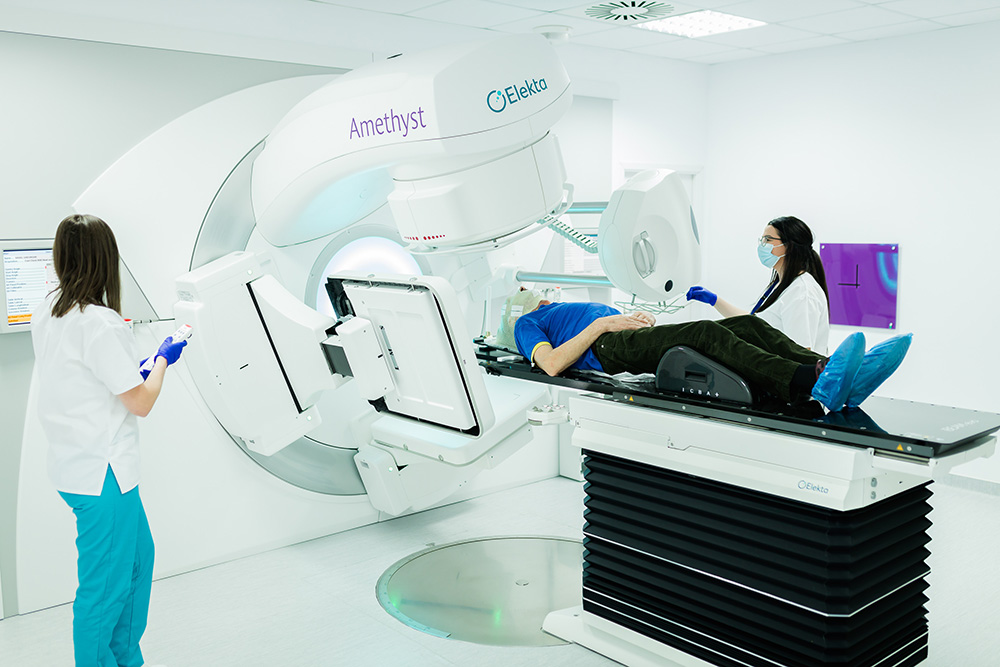Curative radiotherapy acts on the tumor with the aim of completely destroying the cancer cells
Radiotherapy plays an essential role in the treatment of cancer. It uses radiation to destroy cancer cells while causing minimal damage to healthy tissue. More than half of patients diagnosed with cancer can benefit from radiotherapy treatment.
Curative radiotherapy can be:

At Amethyst radiotherapy centres, physicians develop therapeutic strategies for all three types of curative radiotherapy: definitive, adjuvant and neo-adjuvant
The decision to treat a tumour with radiation is based on the location of the primary tumour and whether the tumour cells are radiosensitive. Radiosensitive tumours respond promptly and show regression after moderate doses of radiation. Two examples of highly radiosensitive cancers are leukaemia (cancer of the blood cells) and lymphoma (cancer of the lymphatic system).
Most of the time, radiotherapy is an integral part of combined curative approaches along with chemotherapy, surgery and hormone therapy. For example, radiotherapy combined with chemotherapy has largely replaced surgery as a curative treatment for squamous cell carcinoma of the anus. Radiotherapy is a central component of combined treatment in early stage breast carcinoma, with the aim of breast conservation.
It should also be borne in mind that radiotherapy can be used as a first line of treatment and can replace surgery. Radiotherapy and surgery have similar cure rates for some cancers, and radiotherapy is the best option if the patient has a pre-existing condition that makes surgery impossible or if surgery requires partial or total removal of an organ. For example, radiotherapy may be chosen in laryngeal cancer to preserve the voice.
Radiotherapy is the most effective treatment when a tumour is easily accessible and located away from major body organs. Testicular cancer, for example, is one of the best candidates for radiotherapy. During the process of radiotherapy treatment for testicular cancer, the rest of the body can be easily protected from radiation. Radiation can be directed from all angles to increase the effectiveness of the treatment.
Modern curative radiotherapy means that the relationship between tumour tissue and normal, healthy tissue is such that curative doses of radiation can be delivered without excessively damaging normal tissue. In the case of radiosensitive tumours (including cervical, laryngeal, breast and prostate cancers), radiotherapy may be the only treatment needed to treat and cure them.
Because radiation can affect normal as well as cancerous cells, its distribution is very carefully planned (by radiotherapists and physicists) to exclude vital tissues and organs. Patients are treated over time with several small doses of radiation (e.g. 25 sessions with an administered dose of 2Gy per session) so that their healthy cells can repair much of the effects of the radiation.
The radiotherapist develops and prescribes the treatment plan for each patient and ensures that each treatment is administered correctly. It works in close collaboration with other doctors, i.e. the patient’s treating physicians and all members of the Amethyst team (oncology doctors, physicists, technicians, nurses, pharmacists, psychologists, nutritionists) within the Oncology Committee.
Phone: 021.9368
Address: no 42, Drumul Odăii, Otopeni, Ilfov County
Phone: 021.9368
Address: no 486G, Răzoare Street, Florești, Cluj County
Phone: 021.9368
Address: no 12, Bela Bartok Street, Dumbrăvița, Timiș County
Phone: 021.9368
Address: no 10, Louis Pasteur Street, Alba-Iulia, Alba County
Phone: 021.9368
Address: no 31H, Ion Ionescu de la Brad, Piatra Neamț, Neamț County